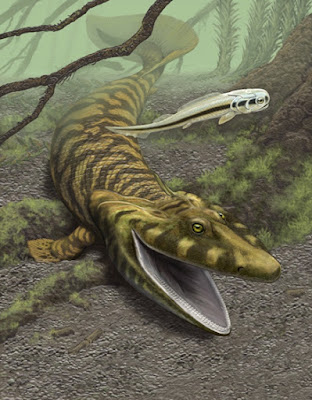Bony Fish
Bony Fish
There are a great many bony fish species, as they have evolved
and adopted to live in all kinds of habitats, both in salt water and fresh
water. Although there are different biological or taxonomic groups to which the
bony fish species belong, they are also grouped according to ecological
factors, such as the types of habitat they inhabit and the lifestyles they lead
within these habitats. Unfortunately, some species of bony fish are becoming
extinct because they only live in particular habitats that are now being
polluted or destroyed.
All fish living in salt water are properly known as marine fish,
while those that live in habitats such as those that live in habitats such as
rivers, lakes and swamps are properly described as fresh water fish. There are
species that break the rules and prefer brackish water, which means the water
is slightly salty, where rivers pour into oceans in estuaries and deltas. Good examples
are the mudslippers (oxudercinae), which are also amphibious, meaning they are
able to leave the water by using their pectoral fins as limbs. There are also species that spend parts of their lives in either
salt water or freshwater and are known as either anadromous or catadromous.
Atlantic salmon (salmo salar) are anadromous, as they breed in freshwater and
their offspring then travel to salt water to grow and mature into adult fish
where as European eels are catadromous, as they breed in salt water and their
young travel to freshwater to grow and mature into adults. As water provides a
three- dimensional environment, many fish have a tendency to spend most of
their time in particular regions of the water. Fish that frequent the seabed or
riverbed are described as benthic species. Some rest on the sediment, while
others hide within it. Above the benthic zone there is the demersal zone and
above that is pelagic zone, both of which are home to particular species of
fish, too. Where the water meets the land at its edges there is a fourth
region, known as the littoral zone, which also has its specific species. In oceans,
this is often described as the intertidal zone, as the water`s edge moves up
and down with the tide. In order to find food, fish need to move about, or
migrate. Some species move only short distances within their habitat, while
others may migrate over significant distances or even to different parts of the
world. Changes in the seasons may cause these geographical migrations across
oceans or along rivers. Fish will also travel to different depths, according to
day and night, because food animals do the same. This is known as circadian
migration.
The bodies of bony fish are covered with overlapping scales,
which protect the body but also allow flexibility. The scales also serve to
provide fish with colours and patterns. These can be for various purposes, such
as indicating the sex of a fish, to camouflage it from predators or prey or to
warn enemies that a fish is poisonous. Scales may also be smooth or textured
for similar reasons. Fish with silvery scales use them to reflect light as a
way of confusing attackers. Many open water fish display counter shading, too.
This means that they are dark above and light below so that a predator is less
able to see them against the bottom or against the sky respectively.
The heads of bony fish are covered with plates that provide
armor for protection. The eyes are able to move but they are unable to close as
they have no eyelids. The mouth is equipped with functional jaws, which allow
fish to open and close their mouths. Some species have lips because they feed
by sucking in and sifting detritus, while others have teeth because they feed
by biting their food, whatever it happens to be. Some species have teeth that
have been fused into a beak- like structure as they peck at their food. Behind the
head, on each side, there is a gill cover, or operculum. Each gill cover can
open to expel water from which the gills have removed oxygen, as that is how
fish breathe without needing to come to the surface to breathe air. The gills
are red, feathery organs, which allow blood to come close to the surface over a
high surface area, so that as much oxygen as possible can be absorbed. Typical bony
fish include species from the mackerel and tuna family (scombridae), the trout
and salmon family (salmonidae), the carp and goldfish family (gadidae), the sea
bass family (moronidae), and the mullet family (mugilidae). Most typical fish
belong to the perciformes order, which happens to be the largest order of
vertebrate species, with over 7,000 members.
Reference
Also See
• Parrots
• Bats
• Bears
• Birds
©
Don`t Kill Creatures of
Nature, You have No Right to Do That
Being Vegetarian, Love
Creature of Nature
Live and Give Space for
another Life
Save Nature
Love Nature













Comments
Post a Comment
Thanks For Your Valuable View.